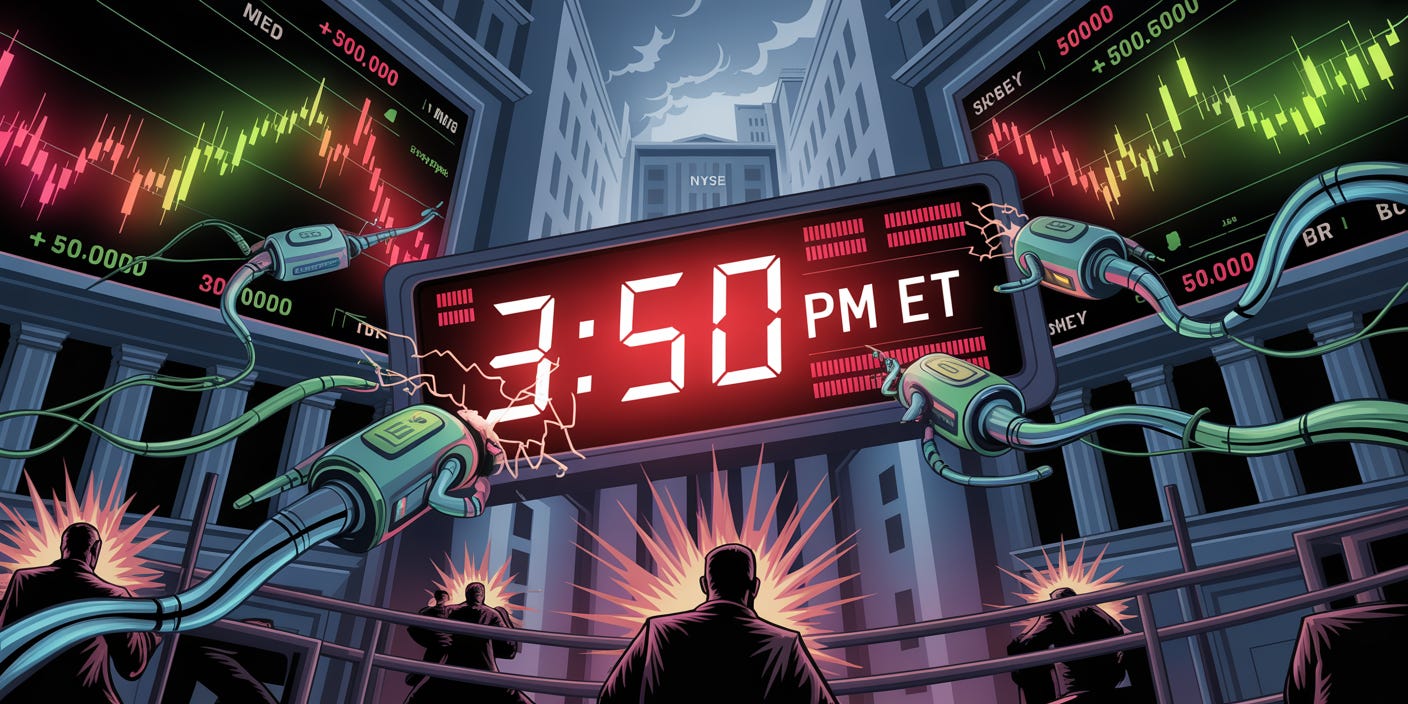The 3:50 PM Market Frenzy Explained
Why the Last 10 Minutes of Trading Are Chaos
If you watch the markets every day, you’ve probably noticed that weird, chaotic burst of activity around 3:50 p.m. Eastern. Stocks start whipping around, spreads widen, and for a minute or two, it feels like the algos have completely taken over.
They have.
But not for the reason most people think.
Let’s break down what’s actually happening in those final ten minutes of the trading day.
It’s Due to MOC Orders
At 3:50pm Eastern time, the New York Stock Exchange publishes the MOC/LOC order imbalance data.
MOC stands for Market-on-Close. LOC stands for Limit-on-Close. These are orders that will execute at exactly 4:00pm at the closing auction price, regardless of where the stock is trading in the seconds before the bell.
Why does this matter? Because at 3:50pm, the exchange essentially shows everyone its cards. It reveals whether there’s a massive imbalance of buy orders versus sell orders waiting to execute at the close.
Imagine you suddenly learned that there’s $500 million more in buy orders than sell orders for Apple stock, all scheduled to hit at 4:00pm. What would you do? You’d probably buy Apple right now, anticipating that the closing auction will push the price higher.
Now imagine that every algorithmic trading system on Wall Street just received that same information at the exact same microsecond.
Front-running the imbalance. If the data shows a big buy imbalance, algos will immediately start buying, expecting the closing auction to push prices up. If there’s a sell imbalance, they’ll sell, anticipating downward pressure.
What It Looks Like on Your Screen
From 3:50pm to 4:00pm, the market enters a different mode entirely:
Sudden volume spikes. Stocks that were trading 100,000 shares every five minutes suddenly see millions of shares trade in seconds.
Violent price swings. A stock drifting at $50.00 might suddenly jump to $50.25 or drop to $49.75 with no news, no earnings release, no fundamental reason whatsoever.
Bizarre pinning behavior. On options expiration days, you’ll see stocks get magnetically pulled toward major strike prices as traders and algos battle over where the close will land.
Reversals that make no sense. A stock selling off all day might suddenly rip higher in the last 10 minutes. Not because anything changed fundamentally, but because the MOC data revealed an unexpected imbalance.
It’s Not Manipulation
Many traders on platforms like X believe 3:50pm is when manipulation kicks in, but this isn’t some market manipulation. The exchanges publish order imbalance data to promote transparency. The problem is that when you give sophisticated algorithms transparency into future order flow, they will exploit it.
And because these systems operate in microseconds, their collective response creates price action that looks insane to human traders who don’t understand what’s happening.
What Retail Traders Should Do
For retail traders, keep in mind that from 3:50pm to 4:00pm, you’re no longer trading against other retail traders. You’re swimming with ultra-fast algorithms that have better information, faster execution, and sophisticated models predicting closing auction outcomes.
They know what you don’t know. They can react before you can blink. And they’re designed specifically to extract profit from this 10-minute window.
If you don’t understand it then don’t trade the close.


